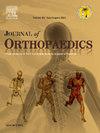Developing and analyzing a Nanocomposites coated material for hammertoe implants
IF 1.5
Q3 ORTHOPEDICS
引用次数: 0
Abstract
Hammertoe implants, frequently used for arthroplasty or proximal interphalangeal joint arthrodesis, have serious drawbacks because of bacterial colonization and material corrosion, which can result in infections and other problems. This study creates a new nanocomposite covering to improve the corrosion resistance, antibacterial qualities, and biocompatibility of 316L stainless steel (SS). 316L SS was treated with a nanocomposite made of graphene oxide (GO), zirconia (ZrO₂), and hydroxyapatite (HAp). The coating's structural and functional characteristics were examined using Fourier-transform infrared spectroscopy (FTIR), scanning electron microscopy (SEM), and energy-dispersive X-ray spectroscopy (EDX). Standard assays were used to evaluate the coated material's antibacterial activity, and simulated bodily fluid (SBF) was used to assess corrosion resistance in vitro. Biocompatibility was verified using assays for cell survival. Apatite layer formation during SBF immersion indicated increased bioactivity and the results showed that the HAp-ZrO₂-GO nanocomposite coating greatly increased the corrosion resistance of 316L SS. The coating showed anti-inflammatory and potent antibacterial qualities, successfully preventing bacterial colonization. Additionally, cell survival tests verified the coated material's biocompatibility, indicating that it would be safe for use in biomedical applications. This work presents a scalable and reasonably priced process for creating bioactive nanocomposite coatings for medical implants. The HAp-ZrO₂-GO coating addresses important drawbacks of conventional implant materials by improving physico-chemical interactions and providing better performance. With significant ramifications for developing biomedical engineering and enhancing patient outcomes, these results demonstrate the potential of the HAp-ZrO₂-GO nanocomposite as a workable option for long-lasting, antimicrobial, and biocompatible bioimplant coatings.

锤状趾植入物纳米复合涂层材料的研制与分析
锤趾植入物常用于关节置换术或近端指间关节融合术,由于细菌定植和材料腐蚀,可能导致感染和其他问题,因此存在严重的缺陷。本研究创造了一种新的纳米复合材料覆盖层,以提高316L不锈钢(SS)的耐腐蚀性、抗菌性和生物相容性。采用氧化石墨烯(GO)、氧化锆(ZrO₂)和羟基磷灰石(HAp)组成的纳米复合材料对316L SS进行了处理。利用傅里叶变换红外光谱(FTIR)、扫描电镜(SEM)和能量色散x射线光谱(EDX)对涂层的结构和功能特性进行了表征。采用标准测定法评价包覆材料的抗菌活性,采用体外模拟体液(SBF)评价包覆材料的耐腐蚀性。通过细胞存活试验验证生物相容性。结果表明,在SBF浸泡过程中形成的磷灰石层的生物活性增加,HAp-ZrO₂-GO纳米复合涂层大大提高了316L SS的耐腐蚀性,涂层具有抗炎和有效的抗菌特性,成功地阻止了细菌的定植。此外,细胞存活测试验证了涂层材料的生物相容性,表明它在生物医学应用中是安全的。这项工作提出了一种可扩展且价格合理的工艺,用于制造用于医疗植入物的生物活性纳米复合涂层。HAp-ZrO 2 -GO涂层通过改善物理化学相互作用和提供更好的性能,解决了传统植入材料的重要缺点。这些结果对发展生物医学工程和提高患者预后具有重要影响,表明HAp-ZrO 2 -GO纳米复合材料作为持久、抗菌和生物相容性生物植入物涂层的可行选择。
本文章由计算机程序翻译,如有差异,请以英文原文为准。
求助全文
约1分钟内获得全文
求助全文
来源期刊

Journal of orthopaedics
ORTHOPEDICS-
CiteScore
3.50
自引率
6.70%
发文量
202
审稿时长
56 days
期刊介绍:
Journal of Orthopaedics aims to be a leading journal in orthopaedics and contribute towards the improvement of quality of orthopedic health care. The journal publishes original research work and review articles related to different aspects of orthopaedics including Arthroplasty, Arthroscopy, Sports Medicine, Trauma, Spine and Spinal deformities, Pediatric orthopaedics, limb reconstruction procedures, hand surgery, and orthopaedic oncology. It also publishes articles on continuing education, health-related information, case reports and letters to the editor. It is requested to note that the journal has an international readership and all submissions should be aimed at specifying something about the setting in which the work was conducted. Authors must also provide any specific reasons for the research and also provide an elaborate description of the results.
 求助内容:
求助内容: 应助结果提醒方式:
应助结果提醒方式:


